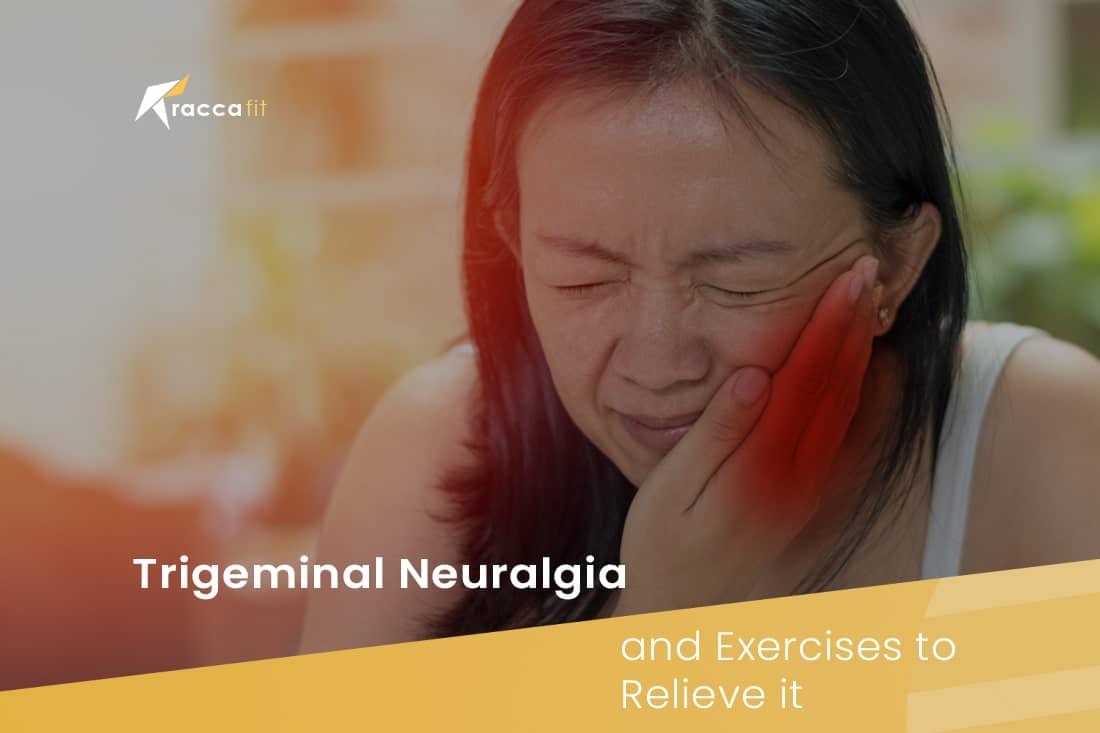Trigeminal neuralgia is a condition that can turn the simplest daily activities into painful ordeals. The good news is that there are non-invasive approaches, particularly targeted exercises, that can play a pivotal role in managing this debilitating condition. In this comprehensive guide, we will delve deeper into the world of trigeminal neuralgia, explore the limitations of traditional treatments, and discover how various types of exercises, mindfulness, and lifestyle adjustments can offer relief.
Understanding Trigeminal Neuralgia
Trigeminal neuralgia is often described as one of the most excruciating pains known to humanity. It is a neurological disorder that affects the trigeminal nerve, which is responsible for transmitting sensory information from the face to the brain. The hallmark of this condition is sudden, stabbing facial pain that can be triggered by the slightest touch, a gentle breeze, chewing, or speaking. The pain episodes are typically short-lived but intense and can lead to anxiety, depression, and social isolation.
Prevalence and Demographics
Trigeminal neuralgia is more common than one might think. Although it can affect people of all ages, it is more prevalent in individuals over the age of 50, with women being slightly more susceptible. Additionally, trigeminal neuralgia can result from various causes, including blood vessel compression or nerve damage. Understanding the demographics and prevalence of this condition is essential in seeking effective management techniques.
Trigeminal neuralgia often starts with a trigger zone on the face. The most commonly affected area is the second and third divisions of the trigeminal nerve, which cover the cheek and jaw. The pain is typically one-sided and severe, often described as electric shock-like or stabbing.
While the exact cause of trigeminal neuralgia isn’t always clear, it can be associated with various factors. The most common cause is compression of the trigeminal nerve by a blood vessel. Other potential causes include multiple sclerosis, nerve damage due to injury, or the presence of a tumor pressing on the nerve.

Traditional Treatments for Trigeminal Neuralgia
Conventional treatments for trigeminal neuralgia primarily include medications and surgical interventions. These treatments can provide relief, but they come with their fair share of limitations and challenges that may not be suitable for everyone.
Success Rates and Challenges
Medications, such as anticonvulsants and muscle relaxants, can offer relief from pain, but they often lose their effectiveness over time. Additionally, the side effects of these medications can be challenging to manage. Surgical interventions, such as microvascular decompression or rhizotomy, are effective in many cases but carry inherent risks, and not all individuals are suitable candidates for these procedures.
Surgical options often involve invasive procedures that aim to alleviate the pressure on the trigeminal nerve. Microvascular decompression, for instance, involves moving blood vessels that are compressing the nerve. Rhizotomy, on the other hand, damages the nerve to block pain signals.
The Power of Exercises in Managing Trigeminal Neuralgia
Exercise, as a non-invasive and complementary approach, has garnered significant attention as a valuable tool in the management of trigeminal neuralgia. Scientific evidence supports the notion that regular exercise can improve pain tolerance and overall quality of life for individuals living with this condition.
Scientific Evidence for Trigeminal Neuralgia and Exercise
Recent studies have revealed that exercise can influence the brain’s response to pain signals, reducing pain perception. This is particularly promising for individuals with trigeminal neuralgia, as it helps decrease the intensity and frequency of pain episodes. The evidence behind exercise as a means of pain management is growing, providing hope for those who seek relief.
According to a research in the “Journal of Pain Research,” trigeminal neuralgia sufferers who regularly exercised experienced much less intense and frequent pain. Additionally, these people showed enhanced psychological health and an improved capacity for pain management.
Types of Exercises
Exercise is a diverse treatment option for trigeminal neuralgia. You may design your routine to target certain parts of pain management by learning the various sorts of workouts.

Facial Muscle Relaxation Techniques for Trigeminal Neuralgia
Facial muscle relaxation exercises aim to alleviate tension in the facial muscles, which can trigger pain episodes. By gently massaging and stretching these muscles, you can reduce the intensity of pain episodes. Proper technique and consistency are key in these exercises. Numerous real-life case studies demonstrate the effectiveness of these exercises, offering hope to those living with trigeminal neuralgia.
Facial muscle relaxation exercises involve gentle massage and stretching of the facial muscles. These exercises can help reduce muscle tension, which may contribute to pain episodes in individuals with trigeminal neuralgia.
Exploring Relaxation Techniques
One effective approach is to explore relaxation techniques to reduce muscle tension. Progressive muscle relaxation, a method of tensing and relaxing specific muscle groups, can be particularly helpful. By practicing this technique regularly, individuals can learn to recognize and release tension in their facial muscles, potentially reducing the frequency and intensity of pain episodes.
Nerve-Gliding Exercises
Exercises that promote nerve gliding aim to lessen nerve compression. These workouts call for precise motions intended to support smooth nerve activity, possibly lessening painful episodes. Clinical trials and other research on nerve-gilding activities have shown promise in relieving symptoms in a variety of individuals.
Breakthroughs in Neuropathic Pain Research
The ongoing pursuit for relatively new medications and procedures for neuropathic pain, especially trigeminal neuralgia, is an interesting development in the area. Neuropathic pain is complex, and researchers are continuously looking for unique ways to treat it and better comprehend its causes.
Recent research has found possible innovations in the treatment of neuropathic pain, such as the creation of brand-new drugs that target the precise pathways involved in pain signaling. For patients who suffer from trigeminal neuralgia, these drugs may provide better pain relief with fewer side effects.
Mind-Body Techniques for Managing Trigeminal Neuralgia
Mindfulness and relaxation exercises can be transformative in managing trigeminal neuralgia. Stress is a known trigger for pain episodes, and these techniques can effectively reduce stress and improve overall well-being.
Incorporating Mindfulness
Incorporating mindfulness into your daily routine can help you manage stress and pain better. Experts suggest mindfulness meditation, deep breathing exercises, and progressive muscle relaxation techniques as effective tools. Personal stories of individuals who found relief through these mind-body techniques are inspiring and provide a sense of community for those looking for non-invasive solutions.

Strategies for Quick Pain Relief
When sudden and severe pain episodes, often referred to as flare-ups, occur, having strategies for quick pain relief is essential. These strategies can help individuals manage intense pain until the episode subsides.
One approach is the use of ice packs. Applying a cold pack to the affected area can help numb the pain and reduce inflammation. Pressure point massage is another method that some individuals find effective. By applying gentle pressure to specific points on the face, it’s possible to alleviate pain temporarily.
Over-the-counter pain relief options can also provide quick relief. Non-prescription pain relievers, such as ibuprofen, can help reduce pain intensity during flare-ups. However, it’s crucial to consult with a healthcare provider before using any medication to ensure it’s safe and appropriate for your condition.
Physical Therapy
Physical therapy is a well-established method for managing various pain conditions, including trigeminal neuralgia. Working with a physical therapist can be a game-changer.
Customized Exercise Plans
Physical therapists can create customized exercise plans tailored to your specific needs and progress. We can also help you to build a workout plan tailored to your goals, preferences, schedule, and available equipment in this page. These plans often involve a combination of exercises targeting various muscle groups and promoting overall pain reduction. Success stories from patients who have experienced significant pain reduction through physical therapy underscore the effectiveness of this approach. The long-term benefits of physical therapy in managing trigeminal neuralgia can be life-changing.
Finding the Right Exercise Routine
Choosing the right exercise routine is essential for managing trigeminal neuralgia. This section offers guidance on how to tailor your exercise regimen to your specific needs and preferences.
Individuals with trigeminal neuralgia should consult with healthcare professionals to create exercise plans that suit their unique circumstances. The right exercise routine can make a significant difference in pain management.
Diet and Nutrition
Nutrition plays an essential role in trigeminal neuralgia management. Certain foods can trigger pain episodes, while others can help alleviate them. Proper hydration is equally important. In this page we can provide a plan customized to meet your exact nutritional needs, keep an eye for any food allergies, and create a meal plan no matter the dietary requirement.

Expert Insights
Experts emphasize the connection between diet and trigeminal neuralgia management. A well-balanced diet that avoids trigger foods and includes anti-inflammatory options can significantly reduce the frequency and intensity of pain episodes. Nutritional guidance for individuals with trigeminal neuralgia is continually evolving, offering new avenues for managing this condition.
- The Role of Support Groups
Support groups play a crucial role in the lives of individuals living with trigeminal neuralgia. They provide a platform for sharing experiences, offering emotional support, and learning from others who face similar challenges.
- The Value of Peer Support
Peer support within these groups can be empowering. When individuals share their personal stories and experiences, it fosters a sense of community and understanding. Support groups can also be sources of valuable information and resources for managing trigeminal neuralgia.
- The Future of Trigeminal Neuralgia Research
Ongoing research into trigeminal neuralgia holds promise for better treatments and management strategies. This section delves into the current and potential future advancements in the field.
- Managing Pain Flare-Ups
Living with trigeminal neuralgia can mean dealing with pain flare-ups. This section provides insights into strategies for managing sudden and severe pain episodes when they occur.
- Personalized Exercise Plans
Individuals with trigeminal neuralgia should consult with healthcare professionals to create exercise plans that suit their unique circumstances. The right exercise routine can make a significant difference in pain management.
Learn More: 7-Day Smoothie Weight Loss Diet Plan: A Goodbye to Boring Diets
Conclusion
In conclusion, exercises offer a non-invasive and complementary approach to managing trigeminal neuralgia. While traditional treatments have their place, exercises can be a valuable addition to your pain management routine. They are versatile, effective, and can be tailored to your needs. It’s essential to consult with a healthcare professional before embarking on any exercise regimen.
Remember, trigeminal neuralgia is a complex condition, and what works for one person may not work for another. Patience and consistency are key. Explore the various exercise options, consult with your healthcare provider, and take charge of your pain management journey.
In your journey to find relief from trigeminal neuralgia, consider joining support groups and seeking resources that offer guidance and assistance to those living with this condition. You are not alone in your battle, and there is hope for a better quality of life.
The key to effective management is a multi-faceted approach that incorporates exercises, mindfulness, professional guidance, and a commitment to making positive lifestyle changes. As research continues to expand our understanding of trigeminal neuralgia, more doors are opening for non-invasive, holistic approaches to pain management.
FAQs
- Are these exercises suitable for everyone with trigeminal neuralgia? Exercise suitability varies from person to person. Consult with a healthcare professional for personalized advice tailored to your specific condition. A professional can help you determine the exercises that are safe and effective for your unique situation.
- Can I completely replace traditional treatments with exercises? While exercises can be a valuable addition to pain management, it’s essential to consult with your healthcare provider for a comprehensive pain management plan. Traditional treatments may still have their place in your treatment plan.
- How long should I perform these exercises to see results? The time it takes to see results varies from person to person. Consistency is key, and results may differ based on individual factors. Consult with your healthcare provider for personalized guidance.
- Are there any exercises I should avoid with trigeminal neuralgia? It’s crucial to consult with a healthcare professional to determine which exercises are safe and suitable for your specific condition. Some exercises may exacerbate symptoms, so professional guidance is essential.
- Are there any specific foods that can help manage trigeminal neuralgia? Certain foods may trigger pain, while others may help alleviate it. Consult with a healthcare provider or nutritionist for personalized dietary recommendations tailored to your needs. Nutrition plays a crucial role in pain management, and personalized advice is valuable.








